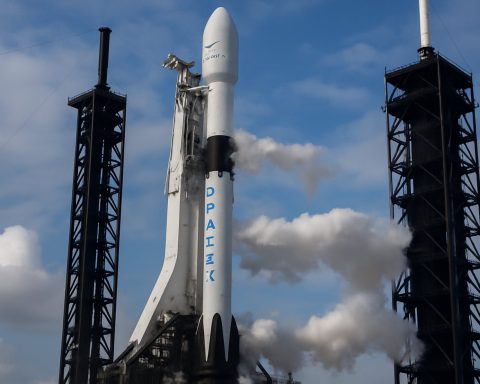A Cosmic Marvel Unveiled
The Hubble Space Telescope, a collaboration between NASA and ESA, has unveiled a captivating image of a rarely observed galaxy known as WISEA J070815.11+210422.3. Situated around 600 million light-years from Earth in the constellation Gemini, this cosmic wonder features a striking blue dot at its center, representing supernova SN 2022aajn.
This breathtaking photograph was captured approximately two months after the explosive event of SN 2022aajn. Previously, aside from its discovery in November 2022, this supernova had not been the focus of scientific research, raising questions about the motivations behind Hubble’s observation.
Researchers explain that SN 2022aajn belongs to the Type Ia category of supernovae, which emerge from the explosive demise of a star’s core. These stellar explosions serve as vital tools for astronomers, allowing them to gauge the distances to far-off galaxies. Because Type Ia supernovae maintain a consistent intrinsic brightness, scientists can compare the observed luminosity with expected values to calculate distances.
However, measuring these distances is complicated by the presence of cosmic dust, which can obscure light from distant objects. To tackle this issue, Hubble is set to conduct a comprehensive survey of 100 Type Ia supernovae across various wavelengths, utilizing infrared imaging to penetrate the dust more effectively. This groundbreaking work will ultimately enhance our understanding of galaxies billions of light-years away and contribute to our knowledge of the universe’s expansion.
The Greater Implications of Cosmic Discoveries
The recent discovery of supernova SN 2022aajn not only captivates astronomers but also carries profound implications for our understanding of the universe and its mechanisms. By mapping out the distances to galaxies using Type Ia supernovae as standard candles, scientists are unraveling the mysteries of cosmic expansion, which has far-reaching consequences within the realm of astrophysics and cosmology.
Understanding the universe’s accelerating expansion can inform theories about dark energy and the ultimate fate of cosmic structures. As researchers unlock the intricacies of space-time through these events, we find ourselves questioning fundamental principles that have held sway over the scientific community. Such revelations can instigate paradigm shifts in how we view not only our universe’s age and composition but also the nature of gravity itself.
Furthermore, these advancements contribute to a larger narrative about humanity’s relationship with the cosmos. As we gain insights into distant galaxies, we bolster our collective cultural imagination about space exploration and our potential role within it. This prepares the groundwork for future missions and technology, impacting sectors like education and aerospace engineering.
In terms of environmental considerations, the techniques developed for cosmic imaging and distance measurement can inspire new technologies that improve our understanding of Earth’s atmosphere and climate systems. Fostering a sense of global stewardship, these insights remind us of our planet’s fragility amidst the enormity of the universe. Ultimately, the exploration of these celestial phenomena has a lasting significance that transcends astronomy, shaping cultural narratives and influencing global scientific endeavors.
Unlocking the Secrets of the Universe: Hubble’s Stunning Discovery of a New Supernova
A Cosmic Marvel Unveiled
The Hubble Space Telescope, through its remarkable partnership between NASA and the European Space Agency (ESA), has recently revealed a stunning image of a little-known galaxy designated WISEA J070815.11+210422.3. Located approximately 600 million light-years from our planet in the constellation Gemini, this galaxy houses the intriguing blue dot at its core, identified as supernova SN 2022aajn.
Captured roughly two months following the supernova’s explosive event, this stunning photograph has gained attention due to the novelty of the supernova itself, discovered for the first time in November 2022. The circumstances surrounding Hubble’s observational campaign raise fascinating questions about the galaxy and supernova, as this type of celestial phenomenon often requires extensive study.
Key Features of SN 2022aajn
1. Type Ia Supernova: SN 2022aajn is categorized as a Type Ia supernova. These stellar explosions occur when a star exhausts its nuclear fuel, leading to the catastrophic collapse of its core. The type Ia supernovae are particularly important in astrological research because they serve as standard candles—these consistent brightnesses allow astronomers to measure cosmic distances.
2. Measuring Cosmic Distances: The importance of Type Ia supernovae lies in their ability to enable astronomers to measure the distances to galaxies billions of light-years away accurately. By comparing their observed luminosity with their expected intrinsic brightness, researchers can calculate precise distances, dramatically enhancing our comprehension of the expanding universe.
Overcoming Cosmic Challenges
A significant challenge in measuring these cosmic distances is the presence of cosmic dust, which can obscure the light from distant objects. Hubble’s upcoming comprehensive survey plans to examine 100 Type Ia supernovae across various wavelengths. By utilizing advanced infrared imaging, Hubble aims to penetrate interstellar dust, providing clearer insights into these distant explosions and their host galaxies.
Trends and Innovations in Astronomical Research
The discovery of SN 2022aajn and the subsequent plans for Hubble’s detailed survey reflect broader trends and innovations in astronomical research:
– Enhanced Imaging Techniques: The use of infrared imaging technology marks a significant advancement in how astronomers study the universe, allowing for better data collection from obscured regions of space.
– Collaboration Drives Discovery: The collaborative efforts between NASA and ESA exemplify how international partnerships can lead to breakthroughs in understanding. Collectively, they push the boundaries of what is possible in astronomical observation and research.
Potential Impact and Future Research
The implications of studying supernova SN 2022aajn are profound. Not only can this research deepen our knowledge about the universe’s expansion, but it can also shed light on the life cycles of galaxies and the fundamental processes governing stellar evolution.
As Hubble continues its mission and telescopes evolve, astronomers remain hopeful that discoveries like these will pave the way for future explorations beyond our current knowledge of the cosmos.
For more insights into the latest astronomical discoveries and research, visit NASA.








